THE American WESTERN
By Jeffrey-Baptiste Tarlofsky
By Jeffrey-Baptiste Tarlofsky
Lesson 22 consists of 7 video lectures and transcripts of those lectures, and 6 film excerpts. Start with the lecture, Part 1 and continue down the page in sequence until you reach the end of the lesson.
レッスン22は、7本のビデオレクチャー(レクチャーのテキストがビデオレクチャーの下に記載されています)と6本の動画で構成されています。
このレッスンは、最初のLecture Part 1から順番に動画を見たりテキストを読んでください。
Part 1
Stagecoach, Red River and Shane each explored particular themes: redemption, revenge, the conflict between the old and the new, and confronting oneself. But one theme that could be found in all three films was the role played by the law. In Stagecoach the first thing we see is that the forces of law and order have been subverted by the Ladies of The Law and Order League who force the local lawmen to enforce their own social prejudices. On the other hand, the Marshall, Curly, at first arrests the Ringo Kid (and seems to look forward to getting the reward for his capture) but at last allows Ringo to escape with Dallas. In doing this, Curly has actually broken the law, but he has served justice.
Justice is a good word to learn, (Justice is, quite literally, an objectively “good” thing). Justice can be defined as “fairness in the way people are dealt with”. To give it a more precise legal definition, it refers to “the impartial adjustment of conflicting claims or the assignment of merited rewards or punishments”. There is an expression “Justice is blind”, which means that justice is impartial and objective. This is an allusion to the ancient Greek figure of justice, a blindfolded woman holding scales in one hand (and sometimes a sword in the other). The blindfold symbolizes the fact that she cannot see who she judges so that she cannot treat friends differently from strangers, or rich people better than the poor ones.
Just because something is legal or because someone obeys the law does not mean justice is served. Wilson was within his legal rights to shoot Torrey under the “stand your ground” laws, but that does not mean justice was done by killing Torrey. Indian lands were all stolen legally through “laws” passed by Congress, but laws are made by lawmakers and lawmakers can be as corrupt and evil as any outlaw. Also remember that “outlaws” were by no means always the bad guys, but simply men who had gotten on the wrong side of the law. The Ringo Kid was an outlaw in Stagecoach and Billy the Kid was an outlaw in The Left handed Gun, yet they were our “white hats” in the films they appeared in. Their search for revenge against the men who killed their friends or family was really a search for justice. They were delivering “justice” to the “black hats” because the lawmen in their towns or territories could not or would not deliver it. In fact, if you remember, one of the men who killed John Tunstall, (the older man who hired Billy and tried to teach how to read), was Marshal Brady of the town of Lincoln, New Mexico. This was not a fictional story; it was actual history. There was a real Marshal Brady who was involved in the murder of the real John Tunstall. So, not all outlaws were bad guys and not all lawmen were good guys.

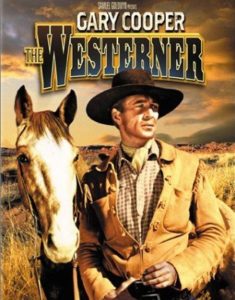
In the West, it was often confusing to know who actually represented real legal authority. In Red River, Thomas Dunson declares “I am the law” when he claims the right to hang the two men who tried to leave the cattle drive. But he is only the law in his own mind (and because he is fast with a gun). But he had no legal right to hang anyone. In Shane it is because there is no actual lawman in the valley that allows Ryker to try to bully the homesteaders off their land, but when it comes to Wilson killing people, Ryker wants things to look legal to witnesses.
In this lesson, we will be taking a look at three films that show us what I call “lawless lawmen”. In the Old West a lawman had to be tough enough to stand up to the toughest outlaws. Very often a town would simply hire the toughest man they could find and make him the town marshal. Quite often the toughest man they could find was himself an outlaw. We saw this in The Gunfighter. The marshal of the town, Mark Strett, is an old friend of Jimmy Ringo’s and a former member of his outlaw gang. Strett chose to “go straight” years before and becomes a good lawman, but many of the men hired to be town marshals, county sheriffs or even judges were deeply corrupt individuals.
One of the most famous examples of the “lawless lawman” is Judge Roy Bean. Bean was a real person and did act as a judge of sorts. However, Bean was also a notorious gunfighter and criminal. The 1940 film, The Westerner, is a mostly fictional account of Bean’s life.
Bean is played by an actor we know well, Walter Brennan, who played Groot in Red River opposite John Wayne. Groot was a grumpy old cook in Red River, but he had a genuinely good heart. But Brennan was sometimes cast as a villain in Westerns…and he was good at playing them as you will see here in this excerpt from The Westerner.
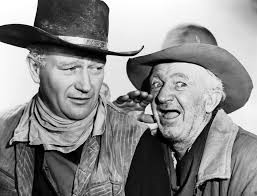
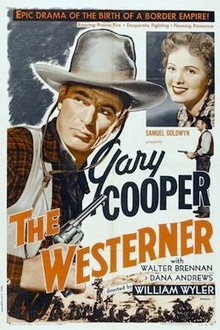
Part 2 – No one would call this justice. To hang a man for accidentally shooting a cow when he was defending himself against the cowboys who shot at his group first is clearly an injustice. But in any legal system there are judges whose job it is to interpret and administer the law. This judge clearly uses the law purely for his own benefit and the benefit of his own friends and business associates, the cattle ranchers. Although this event is fictional the real judge Bean was no less outrageous.
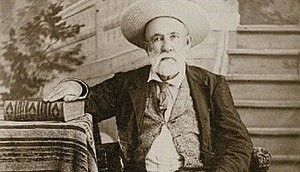
Part 3 – My purpose in showing these excerpts is not to explore the entire movie, but simply to demonstrate what kind of lawman Judge Bean was. The film uses a kind of dark comedy to lighten the mood somewhat, but some of the jokes are pretty grim. When the young woman asks where Shad Wilkins is, Bean answers “he was hanging around a while back, but he ain’t here now”. This is wordplay on the double meaning of “hanging”. To “hang around” means to “spend time aimlessly; wait around or loaf”, but “to hang” someone is, of course, to execute them at the end of a rope they hang from until dead. After his execution Wilkins is left to “hang around” until his body is cold so the undertaker can take him away for burial! We also see that once Bean hangs someone, he confiscates whatever money they had as “court fees”.
Having the horse testify in court is another outrageous humorous moment. But this is what we call “gallows humor” (grim and ironic humor in a desperate or hopeless situation). The character Cole Harden faces execution just as surely as Shad Wilkins did. It truly seems that Harden, (played by screen legend, Gary Cooper), has no chance. However, by the end of the film Harden has not only outsmarted Judge Bean, he also outguns him, killing him. This is all pure fiction. The real Judge Bean died peacefully in bed at the age of seventy-seven after a night of getting extremely drunk.
The next film I will use as an example of the lawless lawman is the 1961 One-Eyed Jacks starring Marlon Brando and Karl Malden. Two outlaws who have just robbed a bank in Mexico and are fleeing from Mexican Army troops.
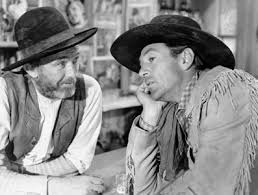
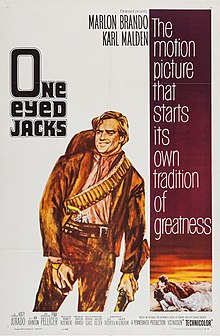
Directed by: Marlon Brando
Produced by: Frank P. Rosenberg
Screenplay by: Guy Trosper and Calder Willingham
Starring: Marlon Brando, Karl Malden, Katy Jurado, Ben Johnson, Pina Pellicer
Music by: Hugo Friedhofer
Distributed by: Paramount Pictures
Running time: 141 minutes
Budget: $6 million
Box office: $4.3 million
Part 4 – You noticed that the Rio Kid cheated when it came time to choose who rode and who stayed. Rio did not cheat to help himself, he cheated to help his partner! Why would he do that? Perhaps the two outlaws’ names explain it. The older man is nicknamed “Dad” Longworth while the younger is “The Rio Kid”. This suggests that they have a relationship like father and son. I don’t think there is any suggestion in the film that the two men were lovers, as Thomas Dunson and Matthew Garth almost certainly were, but even a platonic (i.e., non-sexual) friendship between older and younger men of this sort can be extremely intense. “Dad” is Rio’s mentor, but Rio is the better gunfighter…by far. Rio wants to protect his older friend and feels he is better equipped to hold the ridge while Dad gets the fresh horses. He never imagined that his mentor would betray him.
Of course, you now know what the film turns into; a quest for vengeance. Rio spends five long, miserable years in a Mexican prison until he manages to escape.
His one goal is to find the man who betrayed him. Meanwhile, Dad Longworth has transformed himself.
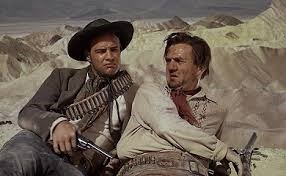
Part 5 – Dad Longworth has become the Sheriff of Monterey! He is now a respectable lawman with his own home and family. He is very far from the dirty, drunken old sadist Judge Bean was. He clearly cares about his appearance and his standing in his community. He doesn’t want anyone to know about his past. But his past (the Rio Kid) has just caught up to him.
The French diplomat Talleyrand-Périgord has been credited with the saying, “Revenge is a dish that must be served cold”. This means that vengeance is often more satisfying if it is not exacted immediately. So, is Rio just toying with Dad Longworth before killing him?
Actually, I think something quite different is happening here. When Dad tells Rio he has something he has been wanting to tell him for a long time Rio seems eager to hear what he has to say. As the scene plays out we have a sense that if only Dad would tell Rio the truth, apologize and offer to make it up to him, Rio might forgive him. He seems to be giving Dad a chance to do exactly that. Instead, Dad makes the situation much worse by lying about what really happened. It proves that for all his new look and new position in society, he is still the same man who betrayed his partner five years ago. It is only after the lie is told that Rio becomes determined to take revenge.
Of course, this is the same situation we saw in the first part of The Left Handed Gun in which Sheriff Brady is actually the black hat and Billy The Kid is the white hat. In One-Eyed Jacks, the outlaw Rio is the white hat while the lawman Dad Longworth is the black hat.
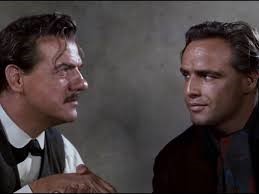
Our final film, Unforgiven, was made much more recently, in 1992. It has the distinction of having won four Academy Awards, including for Best Picture, Best Director and best supporting actor for Gene Hackman playing the part of Sheriff Little Bill Dagget.
I should warn all of you that the following excerpt is both explicitly sexual and also contains graphic violence.
If any of you are bothered by either of these you may, of course, skip the excerpt.
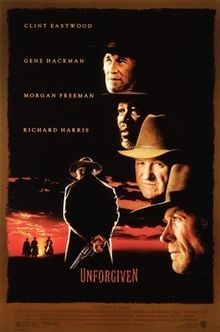
Directed and Produced by: Clint Eastwood
Written by: David Webb Peoples
Starring: Clint Eastwood, Gene Hackman, Morgan Freeman, Richard Harris
Production Company: Malpaso Productions
Distributed by: Warner Bros.
Running time: 131 minutes
Budget: $14.4 million
Box office: $159.2 million
Part 6 – This film reminds me of Stagecoach. In Stagecoach, Dallas was a prostitute forced out of her town by the local lawmen at the behest of the Lady’s of the Law and Order League. She asks, “Haven’t I any right to live?”, but no one is interested in protecting her rights, certainly not the lawmen in the town. She is “just a whore”. In Unforgiven, we see that the social status of prostitutes is so low that the “lawman” of the town simply regards the mutilated girl as “damaged property”, which has to be paid for. But Strawberry Alice, the senior prostitute, organizes the other prostitutes into taking up a collection. They put all their money together and offer a reward to anyone who will kill the two cowboys.
The first potential assassin to arrive in town is a very arrogant man called “English Bob”. To put the next excerpt into context in the timeline of the film, the President of the United States, James A. Garfield, has just been assassinated as the nation is about to celebrate the 4th of July, the day America declared independence from Great Britain. It is Bob’s great misfortune that he and Little Bill know each other.
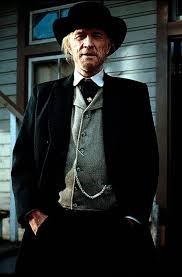
Part 7 – Little Bill Dagget enforces the law in his town through terrible violence. Remember that towns in the old West often hired the toughest man they could find to be their town Marshall or County Sheriff so that he would prevent outlaws from taking over the town or committing crimes. But the question we might ask at this point is whether the cure was worse than the disease. I mean, was it actually worse to have a town controlled by a corrupt lawman like Little Bill, Judge Bean or Dad Longworth or to just have no law at all? Next week we will be screening a film which tries to answer that question, John Ford’s The Man Who Shot Liberty Valance.